A B2B marketer’s 5-point checklist for Q2 2020
No company, role or budget is immune to the impact of COVID-19 on how customers shop, conduct business and interact.

Amberly Dressler

In light of canceled events and slashed budgets, marketers in particular are scrambling to pivot in real-time.
During the height of COVID-19 outbreaks around the world (March 2020), Episerver carried out previously planned research to poll 600 global B2B decision makers about digital experience tactics and technology. Through a series of questions, we guided respondents through a SWOT analysis of the strengths, weaknesses, opportunities and threats facing their unique business as it relates to digital experience. While we will release this second-annual report in its full entirety over the coming weeks, we wanted to move faster to get B2B marketers data that could impact their short-term strategy.
Based on this data of B2B leaders in healthcare, financial services, commercial services and supplies, manufacturing, distribution and high-tech, here is our advice for quick wins and strategic pivoting.
1. Double Down on Effective Channels
Now is not the time to invest dwindling budget in B2B marketing strategies that have yet to prove themselves. Hard decisions in what to cut are happening for marketing departments. Creating a net-new ROI model for a marketing channels you believe in, for example, won't make a strong enough case. This means, invest in B2B marketing strategies that you already know are working. While the messaging will need to change, the channels do not.
Across respondents (roles, industries) in our survey, paid social media is considered the top marketing channel that helps B2B organizations reach their customers most effectively. What’s important to remember for paid activities is a B2B marketer often does not know what a person is viewing when an advertisement appears.
If they are reading about how COVID-19 is impacting their school district on Twitter, for example, a promoted tweet to follow a software CMO is going to appear tone deaf. Or, and here’s another real-world B2B marketing example, a promoted LinkedIn post on how to increase event ROI – in a time when no tradeshows are occurring – is going to hurt a brand’s reputation. Relevancy is critical for all B2B marketing strategies. Hit pause on scheduled campaigns. A B2B marketer must consider hyper-timely messaging when they actually should have a voice in COVID-19 matters or keep to sensitive evergreen messaging when they don’t.
Let’s break down the findings of “What one marketing channel helps your organization reach customers most effectively” by titles and by industry for a more granular look at the most effective channels as self-reported by respondents.
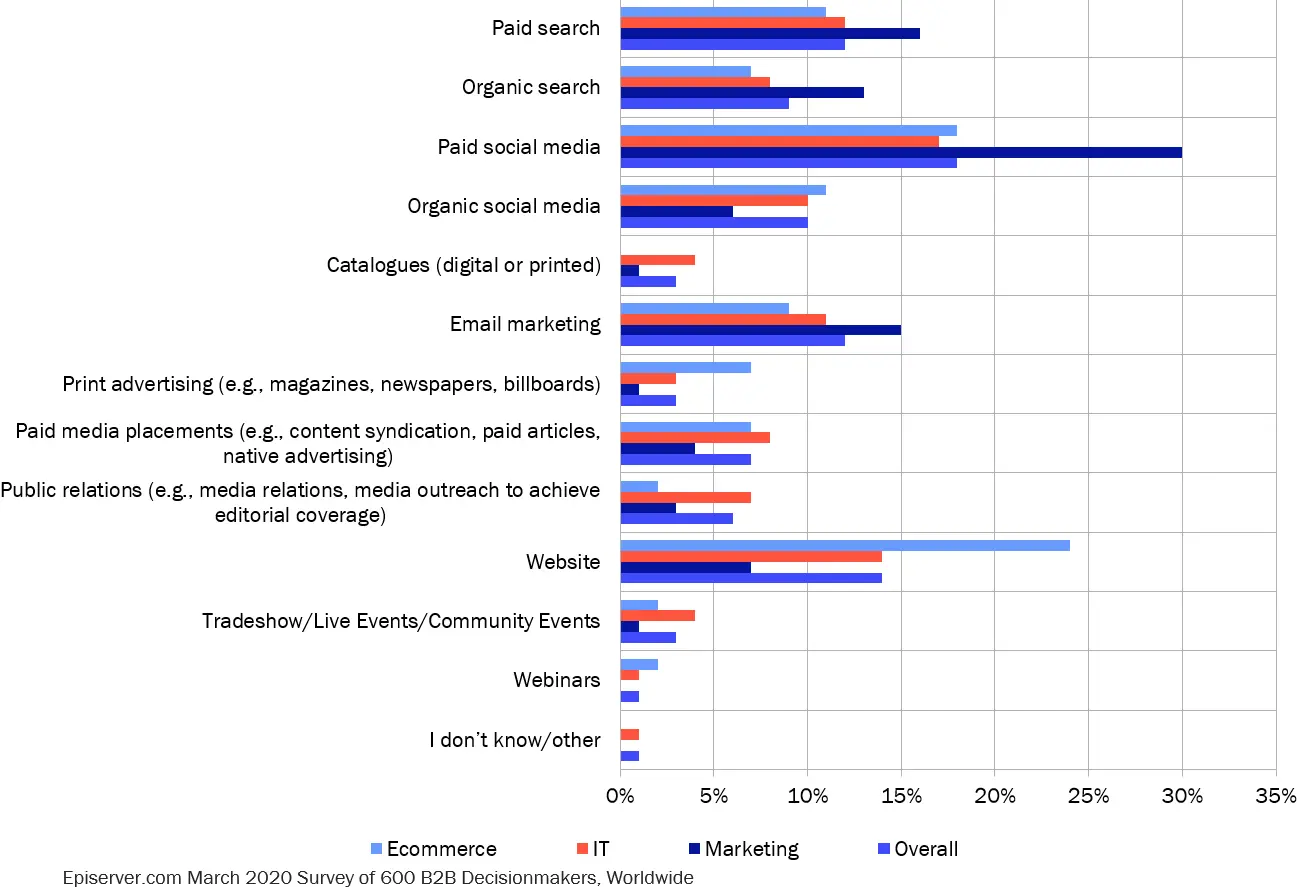
When isolating “marketing” respondents, paid social media is still considered the most effective marketing channel to reach customers (30 percent of B2B marketing leaders agree). Second to paid social, marketing agrees paid search is also a top channel to reach customers (16 percent). Email marketing rounds out the top three effective marketing channels (15 percent).
Some changes appear when looking at the most effective B2B marketing channel by industry. Here are the most effective marketing channels by industry according to our B2B leader respondents:
- Healthcare: Paid search
- Financial Services: Paid social media
- Commercial Services & Supplies: Paid social media
- Manufacturing: Three-way tie of website, email marketing and paid social media
- Distribution: Organic search
- High Tech: Paid social media
It’s equally important to look at what peers consider the least-effective B2B marketing channels. B2B companies have put such a great emphasis on the lack of live events in Q1 and Q2 but only three percent of leaders say they are their most effective channel compared to other efforts. Further, many of these live events are being replaced by webinars when in-person time is limited. Unfortunately, only one percent of B2B leaders say webinars are their most effective marketing channel.
In lean times, focus on what the most effective channels are and make sure the campaigns are supported through a strong click-through experience, which is a combination of relevant content, a fast website experience, an easy way to self-serve and more.
2. Leverage Your Differentiation
The likeliness for new investments in the beginning of this quarter are slim. Many marketers will need to make do with what they have and lean in on areas where they already differentiate. As part of our survey, we asked respondents to answer: What differentiates your company the most from its competitors online?
While the answers were a bit scattered, the consensus was that respondents at B2B organizations most differentiate themselves online from competitors by their digital experience (37 percent), followed by through their social media presence (31 percent) and then through their content marketing (30 percent). Companies can leverage their differentiators further by considering ways to communicate that value proposition to customers.
Episerver customer Metro Bank, for example, already has a differentiating digital experience. It’s leaning into these differentiators during the COVID-19 crisis by reminding customers of their 24/7 online and mobile banking as well as online account application processes and app tutorials for those not accustomed to banking digitally.
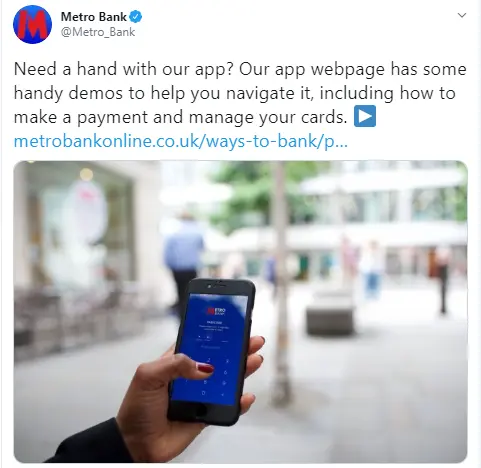
Customers’ needs are narrower during the COVID crisis. Businesses must consider what customers need to get done now and how their already-strong initiatives can help them get it done more efficiently.
Unsurprisingly, the differentiators change based on who we asked and where they worked. Marketing and IT had a difference of opinions, for example, on what differentiates their company online.
Marketing most thought (37 percent) that they differentiate online through their social media presence whereas IT (38 percent) was most likely to say through the digital experience. Ecommerce leaders, on the other hand, believed their top online differentiates were through social causes (31 percent) and the ability to self-serve (31 percent).
With social media being effective for B2B marketing teams (according to respondents), it’s a channel B2B marketers can lean into during these uncertain times by launching organic and paid campaigns relevant to the times.
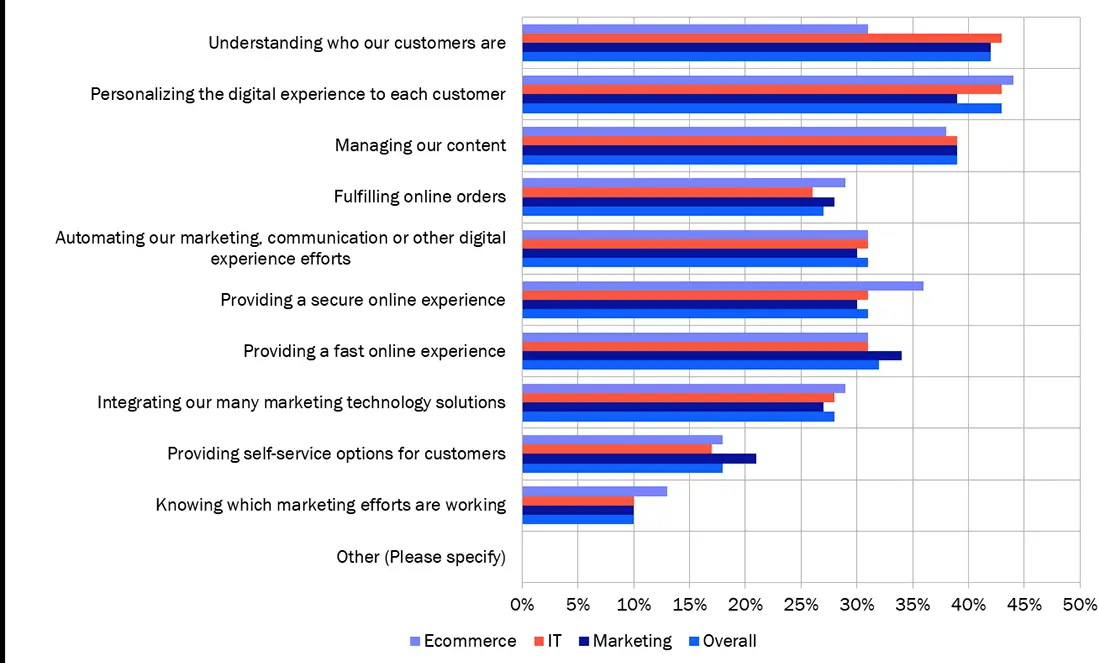
When looking at top differentiators by vertical, these are the ways each industry differentiates their company the most from its competitors online:
- Healthcare: Through our digital experience
- Financial Services: Through our world-class website
- Commercial Services & Supplies: Through our digital experience
- Manufacturing: Through our digital experience
- Distribution: Through our social media presence
- High Tech: Through our digital experience
3. Address Immediate Needs
There is no shortage of improvements marketers want to make to their B2B marketing programs. Often forgotten in this process is prioritizing those improvements; it becomes painfully clear how critical prioritization is when budgets are changed.
As part of our global B2B leaders’ survey, we asked respondents: Which digital experience tactic needs the most improvement at your organization? Across job titles and industries, the top overall answers were: (1) personalizing the digital experience to each customer; (2) understanding who our customers are; (3) managing our content. These responses are deeply intertwined. A company cannot provide a digital experience that reacts to who a person is, without understanding who that customer is and having the ability to serve content that makes sense for them.
One way to understand who customers are and lightly personalize their experience – without bringing on AI-based personalization this quarter – is to look at what customers are searching for on your site and creating content to help them. Episerver’s Deane Barker explains this concept more, here, but the idea is “you are what you read.”
If you are what you read, then customers are showing intent based on what they search for on a website according to Barker. Marrying that intent with the appropriate content is a way to address immediate needs of understanding who customers are and delivering a relevant experience to them. While personalization goes far beyond this to be more automated, individualized and in real-time, creating content based on timely needs is a way to serve the majority of customers or segments of customers with a relevant experience.
Turning back to the data, there were no noticeable differences in industry-specific responses to “Which digital experience tactic needs the most improvement at your organization?”. There were, however, slight differences between marketing, IT and ecommerce leaders’ responses to the question. It should be noted that, overall, teams know what marketing efforts are working as it was the least likely to be selected as a tactic that needs the most improvement.
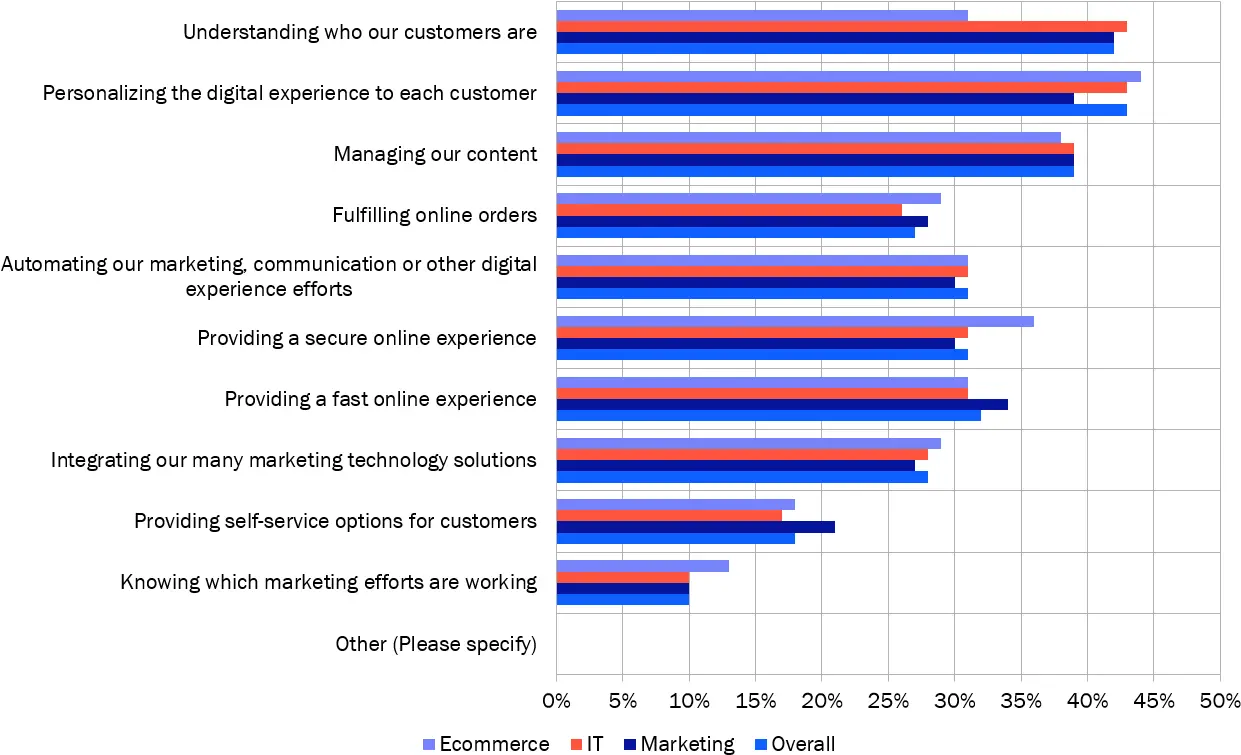
4. Reinvest in Customer Relationships
One of the more inspiring messages to come out of the COVID-19 crisis is that the world truly is in this together. Everyone is feeling the impact of social distancing, health concerns and the economic downturn while others have added stressors like homeschooling their children due to school closures. Being empathetic to customers’ life changes is never more important.
As it stood during March 2020, however, companies are far removed from their customers. When asked “What best describes your company’s relationship with its customers?”, 54 percent of respondents said those relationships were non-existent, strained or developing due to partner-led relationships. There were no notable differences among roles or verticals except marketers were least likely to classify their company’s relationship with customers as “steadfast.” It seems marketing's IT and ecommerce peers have more confidence about their company’s relationship with customers.
| What best describes your company’s relationship with its customers? |
Overall |
Marketing |
IT |
Ecommerce |
|
Strained (we used to manage our customer relationships directly and sell/interact directly, but marketplaces are making that more challenging) |
9% |
9% |
8% |
11% |
|
Steadfast (we’ve always managed our customer relationships directly and have always interacted with them directly) |
47% |
37% |
48% |
49% |
|
Developing (we started to rely less on partners to manage those relationships and are now selling/interacting directly to/with them as well) |
42% |
48% |
41% |
40% |
|
Non-existent (we rely on partners to manage those relationships and sell to them) |
3% |
6% |
3% |
0% |
Finding a way to invest or re-invest in customer relationships is critical and that starts and ends with understanding what customers are going through. Here is a standout B2B marketing example.
Janome, a globally recognized sewing machine manufacturer, uses Episerver to create dynamic content that drives customers to retail stores while growing the brand and getting closer to customers.
With most brick-and-mortars closed worldwide, engaging customers online is the best path to investing in customer relationships. Janome recognized many of its customers are using its products to create do-it-yourself face masks due to COVID-19.
The Janome Facebook page shows high engagement of these face-mask posts, with customers sharing their own face-mask projects as well.
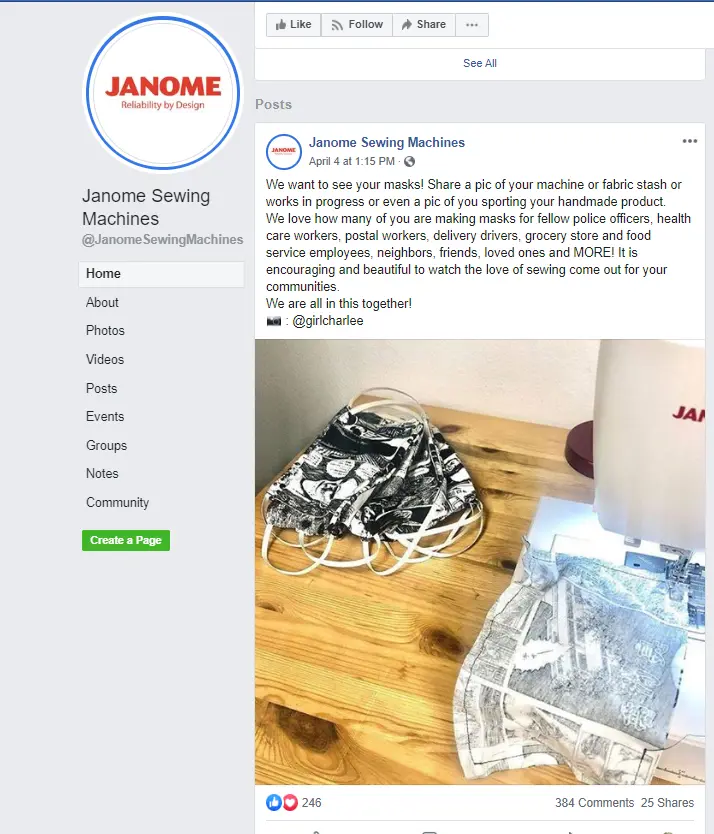
Janome commendably understands how its customers are using its products at this given point of time and is helping them through tutorials and engaging them through user-generated content campaigns.
What are your customers going through? How can you help?
Episerver asked itself these very questions. While we are continuously looking for more ways to help, we made all of our eLearning courses free and are offering free content diagnositcs. It is our hope that through these offerings, our customers can come back stronger knowing how to better use the resources they already have and prioritize the content their customers need.
5. Know Customer Preferences
Customers have a variety of ways they learn more about the B2B companies they may want to do business with. Organizations can struggle to keep up with every channel in which current or prospective customers visit to conduct research – leading to higher acquisition costs and often less understanding of what channel ultimately drove the sale (customer journey analysis can help).
When teams may be smaller or more stretched and budgets may be tighter or even non-existent, it’s important to know how customers want to learn more.
The good news for B2B marketers quickly pivoting from in-person happenings to digital, is that the top preferred channels to learn more about a B2B company are all digital.
According to our survey of 600 global B2B leaders, the top ways respondents want to learn about a fellow B2B company are: (1) the company’s website, (2) email and (3) social media.
With minimal in-person support and limited in-person socializing and shopping options available due to the global pandemic, organizations’ websites are being put to the test. Internally, users need to be able to make content and product changes in real-time without the help of IT; the website also needs to be able to automatically scale for greater traffic with the same or better speed and uptime. Externally, customers demand an intuitive digital experience that reacts to their current needs.
Today’s Checklist Becomes Tomorrow’s Campaigns
This quarter will be one marketers never forget. The plans they made last year and in Q1 are now at risk as uncertainty is rampant. Executives need every team to pivot to support customers in a way that makes sense for the current cultural and economic climate. Understanding what’s already working, what customers really want and how to best support them should be the foundation of B2B marketing strategies.
